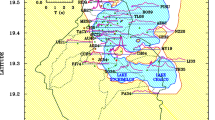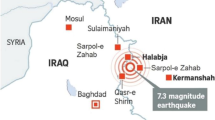Abstract
To highlight the importance of small earthquakes in seismic hazard, a study of the 11 May 2016, Mw 4.9, Tesistan, Mexico earthquake is presented. Due to the close proximity of the event to the city, accelerations were considerably higher than those caused by historical severe earthquakes (6.0 < Mw < 8.2). This paper addresses two objectives related to the Tesistan event: the first is to estimate the focal mechanism solution in order to place the event in the context of the tectonic environment of this area. The second is focused on a vulnerability evaluation of buildings that suffered resonance. Several building’s typologies with variations in construction system and height are assessed in terms of resonance with the structural and soil periods. The results show that around the Zapopan station, strong damage is expected in intermediate to high-rise buildings (12–30 m) with moment resistant frame systems and in reinforced concrete shear walls. Masonry structures around this station may not present resonance. In contrast, in the surroundings of the Guadalajara station, all intermediate height buildings from 9 to 21 m may present resonance.
Similar content being viewed by others
References
Bandy WL and Pardo M (1994), “Statistical Examination of the Existence and Relative Motion of the Jalisco and Southern Mexico Blocks,” Tectonics, 13 (4): 755–768, DOI:https://doi.org/10.1029/94TC00594.
Campillo M, Singh SK, Shapiro N, Pacheco J and Herrmann RB (1996), “Crustal Structure of the Mexican Volcanic Belt, Based on Group Velocity Dispersion,” Geophysics Journal International, 35: 361–370.
Causse M, Laurendeau A, Perrault M, Douglas J, Bonilla LF and Guéguen P (2014), “Eurocode-Compatible Synthetic Time-Series as Input to Dynamic Analysis,” Bulletin of Earthquake Engineering, 12 (2): 755–768.
Castillo-Aja R and Ramírez-Herrera MT (2017), “Updated Tsunami Catalog for the Jalisco-Colima Coast, Mexico, Using Data from Historical Archives,” Seismological Research Letters, 88 (1): 144–158, doi: https://doi.org/10.1785/0220160133.
Chiauzzi L, Masi A, Mucciarelli M, Cassidy JF, Kutyn K, Traber J, Ventura C and Yao F (2012), “Estimate of Fundamental Period of Reinforced Concrete Buildings: Code Provisions vs. Experimental Measures in Victoria and Vancouver (BC, Canada),” 12th World Conference on Earthquake Engineering (WCEE), Lisbon.
Crowley H and Pinho R (2004), “Period-Height Relationship for Existing European Reinforced Concrete buildings,” Earthquake Engineering, 8 (1): 93–119.
Crowley H and Pinho R (2006), “Simplified Equations for Estimating the Period of Vibration of Existing Buildings,” First European Conference on Earthquake Engineering and Seismology, Paper 1122.
Eurocode 8 (2004), Design of Structures for Earthquake Resistance. Part 1: General Rules, Seismic Actions and Rules for Buildings, European Standard.
Ferrari L, Pasquare G, Venegas S, Castillo D and Romero F (1994), “Regional Tectonics of Western Mexico and Its Implications for the Northern Boundary of the Jalisco Block,” Geofisica Internacional, 33: 139–151.
Gallipoli MR, Mucciarelli M and Vona M (2009), “Empirical Estimate of Fundamental Frequencies and Damping for Italian Buildings,” Earthquake Engineering and Structural Dynamics, 38 (8): 973–988.
Gallipoli MR, Mucciarelli M, Šket-Motnikar B, Zupancic P, Gosar A, Prevolnik S, Herak M, Stipcevic J, Herak D, Milutinovic Z and Olumceva T (2010), “Empirical Estimates of Dynamic Parameters on a Large Set of European Buildings,” Bulletin of Earthquake Engineering, 8: 593–607.
Garduño VH and Tibaldi A (1991), “Kinematic Evolution of the Continental Active Triple Junction of Western Mexican Volcanic Belt,” Comptes Rendus Academie des Sciences, 312: 135–142.
Gehl P, Seyedi DM and Douglas J (2013), “Vector-Valued Fragility Functions for Seismic Risk Evaluation,” Bulletin of Earthquake Engineering, 11 (2): 365–384.
Global Centroid Moment Tensor (CMT) project, https://doi.org/www.globalcmt.org/CMTsearch.html (last access March 10 of 2017).
Goel KR and Chopra KA (1997), “Period Formulas for Moment-Resisting Frame Buildings,” Journal of Structural Engineering, 123: 1454–1461.
Hong LL and Hwang WL (2000), “Empirical Formula for Fundamental Vibration Periods of Reinforced Concrete Buildings in Taiwan,” Earthquake Engineering and Structural Dynamics, 29: 327–337.
Ingham JM and Griffith MC (2011a), “The Performance of Unreinforced Masonry Buildings in the 2010/2011 Canterbury Earthquake Swarm,” Report to the Royal Commission of Inquiry, Christchurch, New Zealand: Canterbury Earthquakes Royal Commission.
Ingham JM and Griffith MC (2011b), “The Performance of Earthquake Strengthened URM Buildings in the Christchurch CBD in the 22 February 2011 Earthquake,” Addendum Report to the Royal Commission of Inquiry, Christchurch, New Zealand: Canterbury Earthquakes Royal Commission.
INEGI (2010), Instituto Nacional de Estadística y Geografía, Censo de población del municipio de Tlajomulco de Zúñiga, Jalisco 2000 y 2010. (in Spanish)
Irikura K (1986), “Prediction of Strong Accelerations Motions Using Empirical Green’s Function,” Proceedings of the 7 th Japan Earthquake Engineering Symposium, 151–156.
Lienert BR and Havskov J (1995), “A Computer Program for Locating Earthquakes Both Locally and Globally,” Seismological Research Letters, 66: 26–36.
Luhr JF, Nelson SA, Allan JF and Carmichael ISE (1985), “Active Rifting in Southwestern Mexico: Manifestations of an Incipient Eastward Spreading-Ridge Jump,” Geology, 13: 54–57.
Moore G, Marone C, Carmichael ISE and Renne P (1994), “Basaltic Volcanism and Extension Near the Intersection of the Sierra Madre Volcanic Province and the Mexican Volcanic Belt,” Geological Society of America Bulletin, 106: 383–394.
Nakamura Y (1989), “A Method for Dynamic Characteristics Estimation of Subsurface Using Microtremor on the Ground Surface,” Railway Technical Research Institute, 30: 25–33.
NBCC (2005), National Building Code of Canada, National Research Council Canada.
NEHRP (1994), Recommended Provisions for the Development of Seismic Regulations for New Buildings, Building Seismic Safety Council, Washington D.C.
Nieto-Obregón J, Delgado-Argote L and Damon P (1985), “Geochronologic, Petrologic and Structural Data Related to Large Morphologic Features Between the Sierra Madre Occidental and the Mexican Volcanic Belt,” Geofisica Internacional, 24: 623–663.
Oliveira CS and Navarro M (2010), “Fundamental Periods of Vibration of RC Buildings in Portugal from In-Situ Experimental and Numerical Techniques,” Bulletin of Earthquake Enggineering, 8 (3): 609–642.
Pacheco JF, Mortera Gutiérrrez CA, Delgado H, Singh SK, Valenzuela RW, Shapiro NM, Santoyo MA, Hurtado A, Barron R and Gutiérrez-Moguel E (1999), “Tectonic Significance of an Earthquake Sequence in the Zacoalco Half-Graben, Jalisco, Mexico,” Journal of South American Earth Sciences, 12: 557–565, doi: https://doi.org/10.1016/S0895-981(99)00039-5.
Preciado A, Rodriguez O, Caro-Becerra JL and Lujan-Godinez R (2015), “Seismic Damage Scenarios at Territorial Scale on Unreinforced Masonry in Tlajomulco, Jalisco,” XX National Congress on Earthquake Engineering, Mexican Society of Civil Engineering, November 24–28, Acapulco, Mexico. (in Spanish).
Preciado A, Rodriguez O, Alejandro Ramirez-Gaytan, Rosales G, Caro JL and Lujan-Godinez R (2016a), “Seismic Vulnerability Indicators of the Franciscan Route churches in Tlajomulco, Mexico by Simplified Methods,” 10th International Conference on Structural Analysis of Historical Constructions (SAHC), September 13–15, Leuven, Belgium.
Preciado A, Sperbeck ST and Alejandro Ramirez-Gaytan (2016b), “Seismic Vulnerability Enhancement of Medieval and Masonry Bell Towers Externally Prestressed with Unbonded Smart Tendons,” Engineering Structures, 122: 50–61.
Preciado A, Budelmann H and Bartoli G (2016c), “Earthquake Protection of Colonial Bell Towers in Colima, Mexico with Externally Prestressed FRPs,” International Journal of Architectural Heritage, 10 (4): 499–515.
Ramírez-Gaytán Alejandro, Jorge Aguirre and Carlos Huerta (2010), “Simulation of Accelerograms, Peak Ground Accelerations, and MMI for the Tecomán Earthquake of 21 January 2003,” Bulletin Seismological Society of America, 100 (5A): 2163–2173, DOI: https://doi.org/10.1785/0120090053.
RCDF (2004), Construction Code of Mexico City, Government of Mexico City.
Selvans MM, Stock JM, DeMets C, Sanchez O and Marquez-Azua B (2011), “Constraints on Jalisco Block Motion and Tectonics of the Guadalajara Triple Junction from 1998–2001 Campaign GPS data,” Pure and Applied Geophysics, 168: 1435–1447, DOI:https://doi.org/10.1007/s0024-010-0201-2.
Snoj J, Österreicher M and Dolšek M (2013), “The Importance of Ambient and Forced Vibration Measurements for the Results of Seismic Performance Assessment of Buildings Obtained by Using a Simplified Non-Linear Procedure: Case Study of an Old Masonry Building,” Bulletinn of Earthquake Engineering, 11 (6): 2105–2132.
Suárez G, Garcia-Acosta V and Gaulon R (1994), “Active Crustal Deformation in the Jalisco Block, Mexico: Evidence for a Great in the 16th Century,” Tectonophysics, 234 (1–2): 117–127, DOI:https://doi.org/10.1016/0040-1951(94)90207-0.
Suter M (2014), “Comment on Estimation of Ground Motion in Mexico City from a Repeat of the M1 7:0 Acambay Earthquake of 1912′ by S. K. Singh, A. Iglesias, M. Ordaz, X. Pérez-Campos, and L. Quintanar,” Bulletin of the Seismological Society of America, 104 (5): 2562–2564.
Suter M (2015), “The A.D. 1567 M w 7.2 Ameca, Jalisco, Earthquake (Western Trans-Mexican Volcanic Belt): Surface Rupture Parameters, Seismogeological Effects, and Macroseismic Intensities from Historical Sources,” Bulletin of the Seismological Society of America, 105 (2A): 646–656.
Suter M (2016), “Structure and Holeocene Rupture of the Morelia Fault, Trans-Mexican Volcanic Belt, and Their Significance for Seismic-Hazard Assessment,” Bulletin of the Seismological Society of America, 106 (5): 2376–2388.
Suter M (2017), “The 2 October 1847 M 1 5.7 Chapala Graben Triggered Earthquake (Trans-Mexican Volcanic Belt, West-Central Mexico): Macroseismic Observations and Hazard Implications,” Seismological Research Letters, 89 (1): 1–12.
UBC (1997), Uniform Building Code, International Conference of Building Officials, Whittier, CA.
USGS, “Seismic Hazard Program,” Report of M w. 4.5 Tesistan Earthquake, https://doi.org/earthquake.usgs.gov/earthquakes/eventpage/us10005gn4#origin.
Vidal F, Navarro M, Aranda C and Enomoto T (2014), “Changes in Dynamic Characteristics of Lorca RC Buildings from Pre- and Post-Earthquake Ambient Vibration Data,” Bulletin of Earthquake Engineering, 12 (5): 2095–2110.
Acknowledgment
The authors thank the Seismic Instrumentation Group of the Instituto de Ingeniería of UNAM for providing the accelerogram records and in particular engineers David Almora and Miguel Torres. They also thank SSN for providing regional data to estimate location and focal mechanism.
Author information
Authors and Affiliations
Corresponding author
Rights and permissions
About this article
Cite this article
Ramírez-Gaytán, A., Preciado, A., Bandy, W.L. et al. The Tesistan, Mexico earthquake (Mw 4.9) of 11 May 2016: seismic-tectonic environment and resonance vulnerability on buildings. Earthq. Eng. Eng. Vib. 18, 579–595 (2019). https://doi.org/10.1007/s11803-019-0523-8
Received:
Accepted:
Published:
Issue Date:
DOI: https://doi.org/10.1007/s11803-019-0523-8




